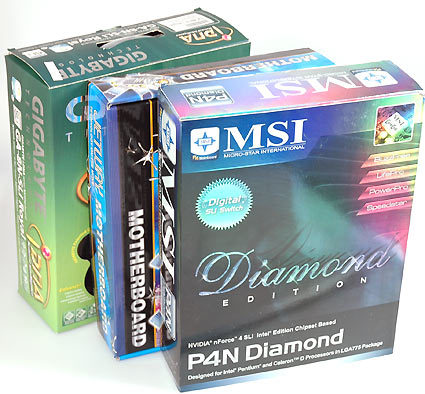Three Premium nForce4 Motherboards from Gigabyte, Jetway, and MSI
Premium Pentium 4 Motherboards, Part 1: The nForce4 Faction
As recently as a few months ago, there was no arguing that the best chipsets for Pentium processors came from Intel. While ATI, ULi, SiS, and VIA all offer competing products, Intel's reputation as the market leader left no doubt about who was in the driver's seat. But with the Intel Edition of its nForce4 chipset, NVIDIA has become the first vendor to call Intel's dominance of the high-end segment of the market into question.
So today, those who want everything from their motherboards have a choice: the Intel 955X, or the NVIDIA nForce4 Intel Edition chipsets. The "Intel Edition" (IE) nomenclature is necessary to distinguish this chipset from the original nForce4 offerings, which were designed for AMD Athlon 64 systems. In that arena, you'll find differing versions of the nForce4 called the Ultra, Professional, and SLI. For the Intel platform, however, the only nForce4 offering available is both SLI-capable and also equipped to the max.
That kind of high-end configuration is important for attracting buyers, because Intel's 955X sets a high standard, with outstanding performance and an unusually rich feature set. This means High Definition Audio 7.1 surround sound, one or two Gigabit Ethernet ports, four SATA-II ports (with support for maximum data transfer rates of 300 MB/s and Native Command Queuing for hard disks), a memory controller for DDR2-667, up to 10 USB 2.0 ports, and numerous PCI and PCI Express expansion slots.
You'll find differences between Intel and NVIDIA where RAID support is concerned, and in the areas of graphics and network interfaces. Intel's MatrixRAID is more flexible than NVIDIA's NVRAID, but to counter that, the graphics specialist offers two x16 PCIe slots for simultaneous use of two graphics cards in SLI mode. As a nice finishing touch, NVIDIA's networking capabilities also include a hardware-supported firewall (even if this item has made headlines recently due to a software bug).
Get Tom's Hardware's best news and in-depth reviews, straight to your inbox.
Current page: Premium Pentium 4 Motherboards, Part 1: The nForce4 Faction
Next Page Where Things Stand
Patrick Schmid was the editor-in-chief for Tom's Hardware from 2005 to 2006. He wrote numerous articles on a wide range of hardware topics, including storage, CPUs, and system builds.
